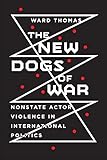The New Dogs of War : Nonstate Actor Violence in International Politics / Ward Thomas.
Material type: TextPublisher: Ithaca, NY : Cornell University Press, [2021]Copyright date: ©2021Description: 1 online resource (276 p.)Content type:
TextPublisher: Ithaca, NY : Cornell University Press, [2021]Copyright date: ©2021Description: 1 online resource (276 p.)Content type: - 9781501758898
- 9781501758911
- 327.1/17 23
- online - DeGruyter
| Item type | Current library | Call number | URL | Status | Notes | Barcode | |
|---|---|---|---|---|---|---|---|
 eBook
eBook
|
Biblioteca "Angelicum" Pont. Univ. S.Tommaso d'Aquino Nuvola online | online - DeGruyter (Browse shelf(Opens below)) | Online access | Not for loan (Accesso limitato) | Accesso per gli utenti autorizzati / Access for authorized users | (dgr)9781501758911 |
Frontmatter -- Contents -- Acknowledgments -- 1. The Fall and Rise of Nonstate Violence -- 2. Coherence and Contestation: Explaining International Normative Change -- 3. Partisans, Liberators, and Militias: Normative Change and the Legitimization of Nonstate Violence -- 4. One Man’s Freedom Fighter?: Normative Change and the Geopolitical Construction of Terrorism -- 5. From Soldiers of Fortune to Fortune 500: Normative Contestation and the Return of Entrepreneurial Violence -- 6. What’s at Stake?: The Implications of Nonstate Actor Violence -- Notes -- Bibliography -- Index
restricted access online access with authorization star
http://purl.org/coar/access_right/c_16ec
As Ward Thomas details in The New Dogs of War, in many countries militias and paramilitary groups wield greater power than national governments, while in some war zones private contractors perform missions previously reserved for uniformed troops. Most ominously, terrorist organizations with global reach have come to define the security landscape for even the most powerful nations. Across the first decades of the twenty-first century we have witnessed a dramatic rise in the use of military force by these nonstate actors in ways that impact the international system, leading Thomas to undertake this valuable assessment of the state of play at this critical moment. To understand the spread of nonstate violence, Thomas focuses on the crucial role played by an epochal transformation in international norms. Since the eighteenth century, the Westphalian model of sovereignty has reserved the legitimate use of force to states. Thomas argues that normative changes in the decades after World War II produced a "crisis of coherence" for formal and informal rules against nonstate violence. In detailed case studies of nonstate militias, transnational terrorist networks, and private military contractors, Thomas explains how forces contesting state prerogatives exploited this crisis, which in turn reshaped international understandings of who could legitimately use force. By considering for the first time all three purveyors of nonstate violence as aspects of the same phenomenon, The New Dogs of War explains this fundamental shift in the norm that for centuries gave states the monopoly on military force.
Mode of access: Internet via World Wide Web.
In English.
Description based on online resource; title from PDF title page (publisher's Web site, viewed 27. Jan 2023)


